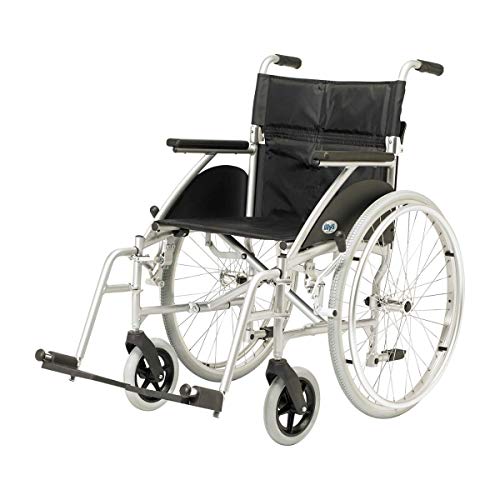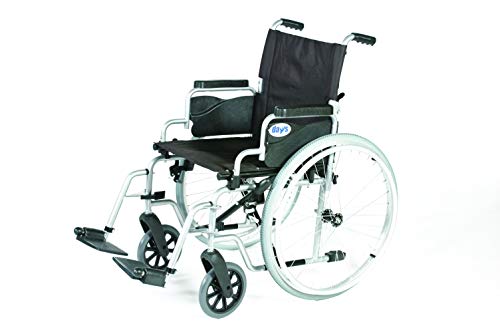How To Use A Self Propelled Wheelchair's History History Of How To Use…
페이지 정보

본문
 How to Use a self propelled wheelchairs lightweight Propelled Wheelchair
How to Use a self propelled wheelchairs lightweight Propelled WheelchairWheelchairs provide mobility and independence for those who have difficulty walking. It is crucial to learn how to maneuver your chair and to get a therapist or occupational therapist to train you in this area.
Wheelies are a common method for moving in a wheelchair. This requires the client to have hands that are large enough to reach across the rims and have strong grip strength to propel them forward.
Seating Position
As the name suggests self-propelled wheelchairs allows you to move yourself and not rely on others. This is the key for many people to regain their independence or maintaining it. It also minimises the risk of injury to the person using the wheelchair and those who are around them.
The user of the wheelchair should be comfortable when seated in the chair. To accomplish this, there are several things you can do. First, make sure that the footplates are in the right position. Release the footrest catch and then swing them around until they are in front of the chair. Make sure that the wheelchair user's feet are seated comfortably on the footplates.
The footrest's height could require lower, particularly for people who are hemiplegic (one side of the body is more affected than the other). If the footrests aren't high enough, they can put pressure on the seat bones and increase pain and discomfort.
A strap for the forehead can help keep the user upright in their wheelchair, particularly if they have weak neck muscles. These can be fitted to wheelchairs without headrests by a specialist in mobility.
It is crucial that if the chair has armrests that they are placed in a good position so that the wheelchair user doesn't hit them with their arms when they move. It is recommended to use the wheelchair with removable or swing-away armrests for this purpose. You can also add foam inserts to the back of armrests in order to raise them to an appropriate height.
A cushion that is well-fitted for a wheelchair is crucial, especially when a person who uses a wheelchair is at a high risk of skin breakdown or pressure sores. Pressure ulcers occur when the skin rubs against wheelchair surfaces. In some cases, skin irritation and blisters may occur after sitting in one position for long periods of time. Repositioning the chair regularly will reduce the risk of developing pressure ulcers.
Pushing
easy self-propelled wheelchair wheelchairs allow users to maneuver themselves and eliminate the need for a third party to push them. They are much easier to maneuver because they have larger rear wheels and push handles. They can travel across various surfaces without fearing of slipping over obstacles or getting stuck.
When you are moving forward with your chair, take care not to grip the handle too hard. Too much pressure can cause your hands to cramp and reduce how much force you can apply. You can also use wheelchair gloves or handrim covers with grip material on the palms. This will help improve the hand's position and increase the amount of force you can apply.
Keep the front casters free of debris, such as rocks or sticks. If the casters are covered with this type of material, it may make it difficult to move in the manner you would expect from your wheelchair and could cause an uncontrolled movement or even injury. If the height of your seat to floor is very high, you might want to consider adding some extra padding on the front casters.
If you are climbing an unassuming step or a curb it is recommended that you enlist the help of a caregiver to push the wheelchair self propelled to provide assistance. If you want to do this independently, you will need more training and practice under the supervision of an expert in health care. When you are doing this, it is crucial that you place the wheelchair directly facing (perpendicular to) the curb or small step and place the front wheels just before the edge of the curb.
When pushing up a slope it is important to have a clear area ahead of you to ensure that you don't run into other people. You will gain speed quickly when you don't have enough space in front of you. You may also collide with another person. To avoid this take care to be aware of the people who are around you when you're on a slope. You should also have a carer or friend prepared to help you in the event that you begin to fall off your wheelchair.
Braking
A self propelled wheelchair requires the user to operate the braking and controlling actions in a certain way to ensure the chair is safe to use. This is especially important when on a slope as it is possible for the centre of gravity to move forward in the event that the braking mechanism is not performed in a controlled way.
Always make sure that your hand is in the proper position when you push a wheelchair. Ideally you should position it at 10 hours (10:00) on the wheel. Release the hand near 2 o’clock (2:00). This will ensure that the majority (or weight) of the body is over the rear wheels, making it easier to push. It also helps to keep the integrity of the shoulder, elbow and wrist joints.
To turn right with a wheelchair, push forward on the right-hand rim, then pull the left-hand rim back. This will cause the wheelchair to turn left and allows you to remain in your chair. Wheelchairs can also be fitted with anti-tip bars to stop the wheelchair from tipping over backwards.
Always refer to the user guide included with your wheelchair to determine the maximum safe slope that your chair is able to traverse. In certain circumstances, the wheelchair might need to be temporarily dismounted and hand operated to overcome steep gradients. In this situation, it is recommended that you seek out a friend or family member for help and follow the steps in the User Guide.
When negotiating kerb stones it is recommended that you mount and dismount via ramps as often as you can. This will reduce the amount of pressure required on the rear and front tyres and allow you to traverse the kerb at a greater speed. The kerb climber option available on many manual wheelchairs can aid in this process by increasing the capacity of the chair by around 10cm (4").
To stop a wheel chair you need to release the brakes gently and then push the joystick toward you. This will de-clutch motor. The wheelchair will stop and you can remove the footrests or make walking aids before leaving the chair.
Steering
The user is accountable for controlling and steering the wheelchair. This can be accomplished in different ways depending on the structure of the chair and any additional features such as armrests or drink/phone holders. Wheelchairs vary in design as well as size and weight. The size of the front casters of a wheelchair can determine the terrain it will handle. Small casters permit wheelchairs to move more quickly, but it can be difficult on rough surfaces such as grass or cobblestone. Large casters let a wheelchair travel over rough surfaces but it isn't as fast.
The wheelchair user should use both hands on smooth, flat surfaces to maintain momentum. This can be done by gripping the handrims and pushing them with both hands. The hands shouldn't be wrapped around the hand rims, as this can cause injuries and cause over-corrections (fish-tailing) when the chair makes a turn. It is recommended that wheelchair users experiment with different levels of leaning forwards and backwards to find the best balance between control and lean.
The person using a wheelchair must anticipate obstacles and plan ahead for more difficult terrain. The user of the wheelchair should keep an eye on both shoulders to avoid running into objects or people. If they are traveling with a caregiver they should be ready to assist if needed. If the wheelchair will be used on a steep slope, a caregiver must assist or drive it until the user is comfortable.
 To turn to turn, the user pulls one hand's rim back while pushing the other forwards. It is best to practice on a flat, smooth surface before moving onto any other surface. The movement can be uncomfortable, and the wheelchair may tip over if it is not mastered. The power wheels of the wheelchair can ease the burden on the user and also make turning easier. It is crucial to be aware that strangers who are not trained tend to push a wheelchair user against their will. The wheelchair user should cover the handles or fold them inwards.
To turn to turn, the user pulls one hand's rim back while pushing the other forwards. It is best to practice on a flat, smooth surface before moving onto any other surface. The movement can be uncomfortable, and the wheelchair may tip over if it is not mastered. The power wheels of the wheelchair can ease the burden on the user and also make turning easier. It is crucial to be aware that strangers who are not trained tend to push a wheelchair user against their will. The wheelchair user should cover the handles or fold them inwards.- 이전글9 Things Your Parents Taught You About Key Audi 24.11.24
- 다음글Unknown Facts About High Stakes Download Link Http Dl Highstakesweeps Com Revealed By The Experts 24.11.24
댓글목록
등록된 댓글이 없습니다.




